
Akkadian is an extinct East Semitic language that was spoken in ancient Mesopotamia from the third millennium BC until its gradual replacement by Akkadian-influenced Old Aramaic among Mesopotamians by the 8th century BC.
Akkadian literature is the ancient literature written in the Akkadian language in Mesopotamia during the period spanning the Middle Bronze Age to the Iron Age.

The Kassites were people of the ancient Near East, who controlled Babylonia after the fall of the Old Babylonian Empire c. 1531 BC and until c. 1155 BC.

Cuneiform is a logo-syllabic script that was used to write several languages of the Ancient Middle East. The script was in active use from the early Bronze Age until the beginning of the Common Era. It is named for the characteristic wedge-shaped impressions which form its signs. Cuneiform was originally developed to write the Sumerian language of southern Mesopotamia. Cuneiform is the earliest known writing system.

Assyriology is the archaeological, anthropological, and linguistic study of Assyria and the rest of ancient Mesopotamia and of the related cultures that used cuneiform writing. The field covers Pre Dynastic Mesopotamia, Sumer, the early Sumero-Akkadian city-states, the Akkadian Empire, Ebla, the Akkadian and Imperial Aramaic speaking states of Assyria, Babylonia and the Sealand Dynasty, the migrant foreign dynasties of southern Mesopotamia, including the Gutians, Amorites, Kassites, Arameans, Suteans and Chaldeans. Assyriology can be included to cover Neolothic pre Dynastic cultures dating to as far back as circa. 8000 BC through to the Islamic Conquest of the 7th century AD
Siduri, or more accurately Šiduri (Shiduri), is a character in the Epic of Gilgamesh. She is described as an alewife. The oldest preserved version of the composition to contain the episode involving her leaves her nameless, and in the later standard edition compiled by Sîn-lēqi-unninni her name only appears in a single line. She is named Naḫmazulel or Naḫmizulen in the preserved fragments of Hurrian and Hittite translations. It has been proposed that her name in the standard edition is derived from an epithet applied to her by the Hurrian translator, šiduri, "young woman." An alternate proposal instead connects it with the Akkadian personal name Šī-dūrī, "she is my protection." In all versions of the myth in which she appears, she offers advice to the hero, but the exact contents of the passage vary. Possible existence of Biblical and Greek reflections of the Šiduri passage is a subject of scholarly debate.
Proto-Euphratean is a hypothetical unclassified language or languages which was considered by some Assyriologists to be the substratum language of the people who introduced farming into Southern Iraq in the Early Ubaid period.

Nanshe was a Mesopotamian goddess in various contexts associated with the sea, marshlands, the animals inhabiting these biomes, namely bird and fish, as well as divination, dream interpretation, justice, social welfare, and certain administrative tasks. She was regarded as a daughter of Enki and sister of Ningirsu, while her husband was Nindara, who is otherwise little known. Other deities who belonged to her circle included her daughter Nin-MAR.KI, as well as Hendursaga, Dumuzi-abzu and Shul-utula. In Ur she was incorporated into the circle of Ningal, while in incantations she appears alongside Ningirima or Nammu.
Agum III was a Kassite king of Babylon ca. mid-15th century BC. Speculatively, he might figure around the 13th position in the dynastic sequence; however, this part of the Kingslist A has a lacuna, shared with the Assyrian Synchronistic Kinglist.
Kassite was a language spoken by the Kassites in Mesopotamia from approximately the 18th to the 7th century BC. From the 16th to 12th centuries BC, kings of Kassite origin ruled in Babylon until they were overthrown by the Elamites. As only a few dozen words are known, none of which have been demonstrably linked to any living or dead language family, Kassite is considered an unclassified language at present, possibly an isolate or belonging to the Hurro-Urartian languages.

The Urra=hubullu is a major Babylonian glossary or "encyclopedia". It consists of Sumerian and Akkadian lexical lists ordered by topic. The canonical version extends to 24 tablets. The conventional title is the first gloss, ur5-ra and ḫubullu meaning "interest-bearing debt" in Sumerian and Akkadian, respectively. One bilingual version from Ugarit [RS2.(23)+] is Sumerian/Hurrian rather than Sumerian/Akkadian.
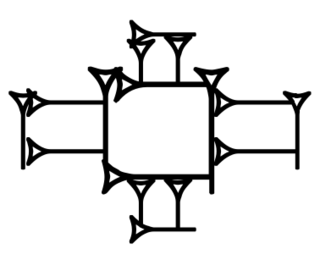
Liste der archaischen Keilschriftzeichen, abbreviated LAK, is a dictionary of Sumerian cuneiform signs of the Fara period, published in 1922 by German sumerologist and theologian P. Anton Deimel (1865–1954). The list enumerates 870 distinct cuneiform signs.
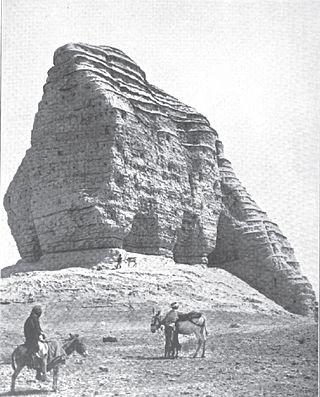
Kurigalzu I, usually inscribed ku-ri-gal-zu but also sometimes with the m or d determinative, the 17th king of the Kassite or 3rd dynasty that ruled over Babylon, was responsible for one of the most extensive and widespread building programs for which evidence has survived in Babylonia. The autobiography of Kurigalzu is one of the inscriptions which record that he was the son of Kadašman-Ḫarbe. Galzu, whose possible native pronunciation was gal-du or gal-šu, was the name by which the Kassites called themselves and Kurigalzu may mean Shepherd of the Kassites.

The First Sealand dynasty, (URU.KÙKI) or the 2nd Dynasty of Babylon, very speculatively c. 1732–1460 BC, is an enigmatic series of kings attested to primarily in laconic references in the king lists A and B, and as contemporaries recorded on the Assyrian Synchronistic king list A.117. Initially it was named the "Dynasty of the Country of the Sea" with Sealand later becoming customary. The dynasty, which had broken free of the short lived, and by this time crumbling Old Babylonian Empire, was named for the province in the far south of Mesopotamia, a swampy region bereft of large settlements which gradually expanded southwards with the silting up of the mouths of the Tigris and Euphrates rivers. Sealand pottery has been found at Girsu, Uruk, and Lagash but in no site north of that. The later kings bore pseudo-Sumerian names and harked back to the glory days of the dynasty of Isin. The third king of the dynasty was even named for the ultimate king of the dynasty of Isin, Damiq-ilišu. Despite these cultural motifs, the population predominantly bore Akkadian names and wrote and spoke in the Akkadian language. There is circumstantial evidence that their rule extended at least briefly to Babylon itself. In later times, a Sealand province of the Neo-Babylonian Empire also existed.

Ur(i)dimmu, meaning "Mad/howling Dog" or Langdon's "Gruesome Hound",, was an ancient Mesopotamian mythical creature in the form of a human headed dog-man whose first appearance might be during the Kassite period, if the Agum-Kakrime Inscription proves to be a copy of a genuine period piece. He is pictured standing upright, wearing a horned tiara and holding a staff with an uskaru, or lunar crescent, at the tip. The lexical series ḪAR-ra=ḫubullu describes him as a kalbu šegû, "rabid dog".

The work known by its incipit, Angim, "The Return of Ninurta to Nippur", is a rather obsequious 210-line mythological praise poem for the ancient Mesopotamian warrior-god Ninurta, describing his return to Nippur from an expedition to the mountains (KUR), where he boasts of his triumphs against "rebel lands" (KI.BAL), boasting to Enlil in the Ekur, before returning to the Ešumeša temple—to “manifest his authority and kingship.”
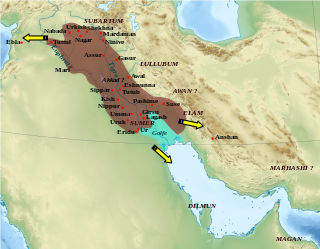
Akkad was the name of a Mesopotamian city. Akkad was the capital of the Akkadian Empire, which was the dominant political force in Mesopotamia during a period of about 150 years in the last third of the 3rd millennium BC.
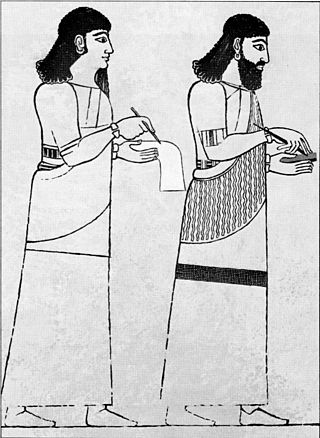
Edubba (Sumerian: 𒂍𒁾𒁀𒀀E2-DUB-ba-a) is the Sumerian for "scribal school." The eduba was the institution that trained and educated young scribes in ancient Mesopotamia during the late third or early second millennium BCE. Most of the information known about edubas comes from cuneiform texts dating to the Old Babylonian period (ca. 2000-1600 BCE).
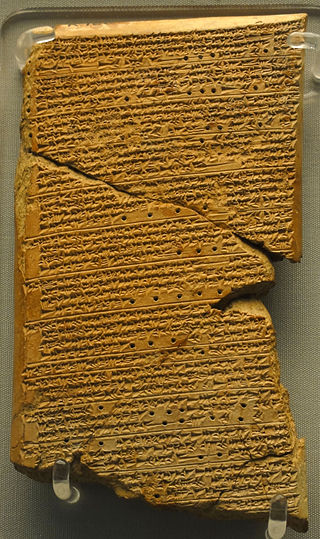
Ninsianna was a Mesopotamian deity considered to be the personification of Venus. This theonym also served as the name of the planet in astronomical texts until the end of the Old Babylonian period. There is evidence that Ninsianna's gender varied between locations, and both feminine and masculine forms of this deity were worshiped. Due to their shared connection to Venus, Ninsianna was associated with Inanna. Furthermore, the deity Kabta appears alongside Ninsianna in many texts, but the character of the relation between them remains uncertain.
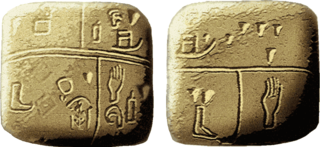
The Proto-Cuneiform script was used in Mesopotamia from roughly 3350 BC to 2900 BC. It arose from the token based system used in the region for the preceding millennia and was replaced by the development of early Cuneiform script in the Early Dynastic I period. While the underlying language of Cuneiform is definitively Sumerian, the language base for Proto-Cuneiform is as yet uncertain.














